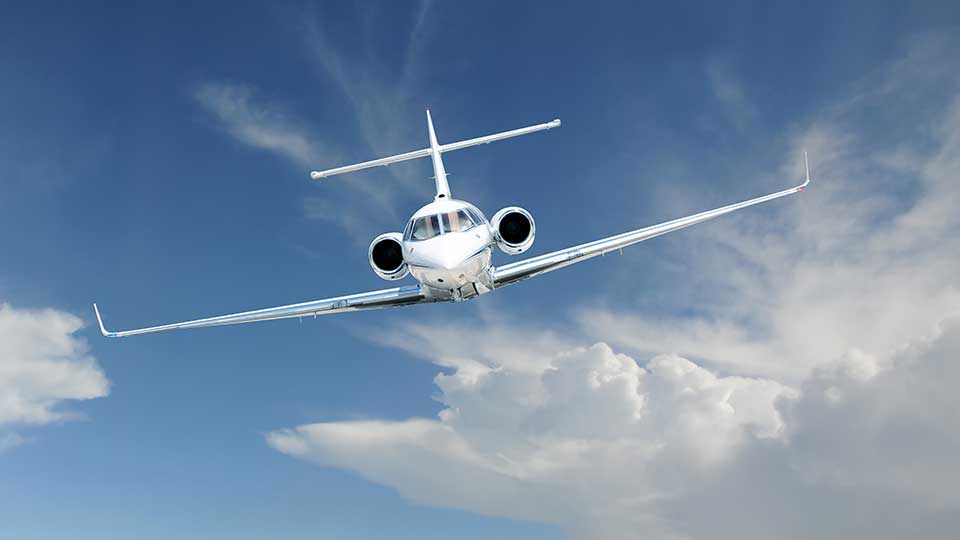History of Gulfstream
Part III

Exapansion Across the World
The need for a longer range Gulfstream surfaced with the capability of flying from New York to Tokyo non-stop or 6500 nautical miles. The Gulfstream GV first flew on November 28, 1995. The GV can fly up to Mach 0.90 and at altitudes of 51,000 feet (15,545 meters) and covers 6,500 nautical miles (12,038 kilometers. Gulfstream added a heads-up display to the GV’s cockpit and wired the cabin as a complete computerized office. The GV typically accommodates four crew members (with a crew rest area) and 14 passengers in an executive configuration. The GV entered into service in June 1997. To date more than 190 GVs were delivered.
- GV General characteristics [1]
- Crew: : 2 pilots, 0–2 attendants
- Capacity: 14–19 passengers
- Length: 96 ft 5 in (29.4 m)
- Wingspan: 93 ft 4 in (28.5 m)
- Height: 25 ft 10 in (7.87 m)
- Wing area: 1,137 ft² (105.6 m²)
- Empty weight: 46,200 lb (21,000 kg)
- Max takeoff weight: 90,500 lb (41,136 kg
- Powerplant:2 × Rolls-Royce BR710A1-10 turbofan, 14,750 lbf (65 kN) each
- Performance
- Cruise speed: Mach 0.85 (488 knots, 904 km/h)
- Range: 5,800 nautical miles (10,742 km)
- Service ceiling: 51,000 ft (15,545 m)
[1] ** NSF/NCAR GV Investigator's Handbook[17]
Transition
General Dynamics purchased Gulfstream Aerospace for US$5.3 billion on July 30, 1999. The Defense Giant Corporation previously owned another aircraft manufacturer and had also produced F-16 fighters for the U.S. military.
Gulfstream modified the GV developing a new airplane defined as an ultra long range aircraft called the G550 linking cities around the world, such as Seoul and Orlando, Florida; Washington D.C. and Dubai; and Tokyo and Paris. The aircraft also featured the new PlaneView cockpit integrating several avionics features, including an infrared camera that revealed terrain and runway lights in low-visibility conditions, known as an Enhanced Vision System. The G550 can accommodate four crew members and up to 18 passengers. The G550 first flew on July 18, 2002, and entered into service in 2003 and still remains in production today.
- G550 General characteristics [1]
- Crew: two
- Capacity: 19 Maximum
- Length: 96 ft 5 in (29.4 m)
- Wingspan: 93 ft 6 in (28.5 m)
- Height: 25 ft 10 in (7.9 m)
- Empty weight: 48,000 lb (21,800 kg)
- Max takeoff weight: 85,100 lb (38,600 kg)
- Powerplant: 2 × Rolls-Royce BR710 turbofan, 15,385 lbf (68.44 kN) each
- Performance
- Cruise speed: 488 knots (562 mph, 0.85 Mach, 904 km/h)
- Range: 5,800 nmi (6,648 mi, 10,700 km)
- Service ceiling: 51,000 ft (15,500 m)
- Max Speed: .885 Mach
[1] ** Flightglobal cabin details
Class Leading Creations
The Gulfstream G650 debuted March 13, 2008 as the most advanced aircraft in business aviation using fly by wire and composite aircraft parts. This aircraft can fly 7,000 nautical miles (12,964 kilometers) with a max cruising altitude of 51,000-feet (15,545-meter) cruising altitude and Mach 0.85 cruising speed. The G650 has a maximum operating speed of Mach 0.925. The G650’s is much wider than it’s predecessor with large panoramic windows that are 33% larger than the trademark Gulfstream Cabin windows. The G650 can accommodate up to 18 passengers in as many as four distinct living areas. The G650 first flew on November 25, 2009, and entered service in December 2012 as the world’s fastest civilian aircraft.
On May 18, 2014 Gulfstream announced a longer range version of the G650 designated the G650ER boasting a range of 7500 NM at Mach .85 due to an increased fuel load of 4000 pounds. This airplane received certification October 8, 2014. Deliveries begin the first quarter of 2015. Existing G650’s can be modified to be re-designated as a G650ER.
In July of 2013 The Gulfstream G650 set the world speed record for a westbound circumnavigation at 41 hours, 7 minutes and as well as claiming 22 city-pair speed records en route. The 20,310-nautical-mile flight started and finished in San Diego, California, with stops in Guam, Dubai and Cape Verde. The G650 flew each leg at Mach 0.90, the aircraft’s standard high speed cruise. March of 2014 the G650ER flew non-stop from Hong Kong to Teterboro, New Jersey, U.S, a distance of 7,494 nautical miles (13,879 km; 8,624 mi); it has also flown non-stop from Los Angeles to Melbourne in Australia.
- G550 General characteristics [1]
- Crew: two
- Capacity: 18 Maximum
- Length: 99 ft 9 in (30.41 m)
- 99 ft 7 in (30.36 m)
- Height: 25 ft 4 in (7.72 m)
- Empty weight: 48,000 lb (21,800 kg)
- Max takeoff weight: 99,600 lb (45,200 kg)
- Powerplant: 2 × Rolls-Royce Deutschland BR725 turbofan, 16,100 lbf (71.6 kN) each
- Performance
- Cruise speed: Mach 0.90
- Range: 7,000 nautical miles (8,050 mi, 12,960 km)
- Service ceiling: 51,000 ft (15,500 m)
- Max Speed: .925 Mach
[1] ** Flightglobal cabin details
Conclusion Part III
October 14, 2014 at the NBAA convention in Orlando, FL, Gulfstream announced their latest additions to Gulfstream family. The Gulfstream G500 and Gulfstream G600 will establish new class-leading benchmarks for optimized performance, cabin design and technology. The aircraft will fly farther and faster than other jets in their classes while providing the comfort of wide cabin aircraft. Gulfstream will have state-of-the-art avionics with the new Symmetry Flight Deck™ using touch-screen displays, active control sidesticks and Intelligence-by-Wire™ flight controls. Deliveries are currently expected sometime in 2017.




















